Analysis and Characterization on Dynamic Recrystallization in Casting AZ31 Mg Alloys Under Plane Strain Compression
Abstract
1. Introduction
2. Materials and Methods
2.1. Plane Strain Compression
2.2. Electron Backscatter Diffraction
3. Results
3.1. Stress–strain Relationships
3.2. Twinning and Recrystallizations
4. Discussion
Author Contributions
Funding
Conflicts of Interest
References
- Sanjari, M.; Farzadfar, S.A.; Utsunomiya, H.; Sakai, T.; Essadiqi, E.; Yue, S. High speed rolling of Mg–3Al–1Zn alloy: texture and microstructure analysis. Mater. Sci. Tech 2012, 28, 928–933. [Google Scholar] [CrossRef]
- Chai, F.; Zhang, D.T.; Zhang, W.W.; Li, Y.Y. Microstructure evolution during high strain rate tensile deformation of a fine-grained AZ91 magnesium alloy. Mater. Sci. Eng. A 2014, 590, 80–87. [Google Scholar] [CrossRef]
- Zhu, S.Q.; Yan, H.G.; Chen, J.H.; Wu, Y.Z.; Liu, J.Z.; Tian, J. Effect of twinning and dynamic recrystallization on the high strain rate rolling process. Script. Mater. 2010, 63, 985–988. [Google Scholar] [CrossRef]
- Zhu, S.Q.; Yan, H.G.; Liao, X.Z.; Moody, S.J.; Sha, G.; Wu, Y.Z.; Ringer, S.P. Mechanisms for enhanced plasticity in magnesium alloys. Acta Mater. 2015, 82, 344–355. [Google Scholar] [CrossRef]
- Zhu, S.Q.; Ringer, S.P. On the role of twinning and stacking faults on the crystal plasticity and grain refinement in magnesium alloys. Acta Mater. 2018, 144, 365–375. [Google Scholar] [CrossRef]
- Liu, X.; Zhu, B.W.; Xie, C.; Zhang, J.; Tang, C.P.; Chen, Y.Q. Twinning, dynamic recrystallization, and crack in AZ31 magnesium alloy during high strain rate plane strain compression across a wide temperature. Mater. Sci. Eng. A 2018, 733, 98–107. [Google Scholar] [CrossRef]
- Zhu, B.W.; Liu, X.; Xie, C.; Wu, Y.Z.; Zhang, J. {10–12} extension twin variant selection under a high train rate in AZ31 magnesium alloy during the plane strain compression. Vacuum 2019, 160, 279–298. [Google Scholar] [CrossRef]
- Zhu, B.W.; Liu, X.; Xie, C.; Liu, W.H.; Tang, C.P.; Lu, L.W. The flow behavior in as-extruded AZ31 magnesium alloy under impact loading. J. Mag. Alloy. 2018, 6, 180–188. [Google Scholar] [CrossRef]
- Zhu, S.Q.; Yan, H.G.; Chen, J.H.; Wu, Y.Z.; Du, Y.G.; Liao, X.Z. Fabrication of Mg–Al–Zn–Mn alloy sheets with homogeneous fine-grained structures using high strain-rate rolling in a wide temperature range. Mater. Sci. Eng. A 2013, 559, 765–772. [Google Scholar] [CrossRef]
- Nakano, H.; Yuasa, M.; Chino, Y. {10–12} twins in the rolled Mg–Zn–Ca alloy with high formability. J. Mater. Res. 2014, 29, 3024–3031. [Google Scholar] [CrossRef]
- Ayoub, G.; Rodrigez, A.K.; Shehadeh, M.; Kridli, G.; Young, J.P.; Zbib, H. Modelling the rate and temperature-dependent behaviour and texture evolution of the Mg AZ31B alloy TRC sheets. Philos. Mag. 2018, 98, 262–294. [Google Scholar] [CrossRef]
- Ostapovets, A.; Bursik, J.; Krahula, K.; Kral, L.; Serra, A. On the relationship between {11–22} and {11–26} conjugate twins and double extension twins in rolled pure Mg. Philos. Mag. 2017, 97, 1088–1101. [Google Scholar] [CrossRef]
- Wan, G.; Wu, B.L.; Zhang, Y.D.; Sha, G.Y.; Esling, C. Strain-rate sensitive of textured Mg–3.0Al–1.0Zn alloy (AZ31) under impact deformation. Script. Mater. 2011, 65, 461–464. [Google Scholar] [CrossRef]
- Zhang, J.; Xie, C.; Zhu, B.W.; Liu, X.; Wang, X.F.; Ma, T.F.; Peng, W.F.; Shu, X.D. Strain-rate effects on twinning, dynamic recrystallization and their competition of casting AZ31 Mg alloys during the plane strain compression. Mater. Res. Exp. 2018, 5, 056532. [Google Scholar] [CrossRef]
- Xie, C.; He, J.M.; Zhu, B.W.; Liu, X.; Zhang, J.; Wang, X.F.; Shu, X.D.; Fang, Q.H. Transition of dynamic recrystallization mechanisms of as-cast AZ31 Mg alloys during hot compression. Int. J. Plast. 2018, 111, 211–233. [Google Scholar] [CrossRef]
- Sitdikov, O.; Kaibyshev, R. Dynamic recrystallization in pure magnesium. Mater. Trans. 2001, 42, 1928–1937. [Google Scholar] [CrossRef]
- Wu, Y.Z.; Yan, H.G.; Zhu, S.Q.; Chen, J.H.; Liu, A.M.; Liu, X.L. Flow behavior and microstructure of ZK60 magnesium alloy compressed at high strain rate. Trans. Nonferrous Met. Soc. China 2014, 24, 930–939. [Google Scholar] [CrossRef]
- Xu, S.W.; Kamado, S.; Matsumoto, N.; Honma, T.; Kojima, Y. Recrystallization mechanism of as-cast AZ91 magnesium alloy during hot compressive deformation. Mater. Sci. Eng. A 2009, 527, 52–60. [Google Scholar] [CrossRef]
- Al-Samman, T.; Molodov, K.D.; Molodov, D.A.; Gottstein, G.; Suwas, S. Softening and dynamic recrystallization in magnesium single crystals during c-axis compression. Acta Mater. 2013, 60, 537–545. [Google Scholar] [CrossRef]
- Guo, F.; Zhang, D.F.; Fan, X.W.; Jiang, L.Y.; Yu, D.L.; Pan, F.S. Deformation behavior of AZ31 Mg alloys sheet during large strain hot rolling process: A study on microstructure and texture evolutions of an intermediate-rolled sheet. J. Alloy. Comp. 2016, 663, 140–147. [Google Scholar] [CrossRef]
- Guo, F.; Zhang, D.F.; Wu, H.Y.; Jiang, L.Y.; Pan, F.S. The role of Al content on deformation behavior and related texture evolution during hot rolling of Mg–Al–Zn alloys. J Alloy. Comp. 2017, 695, 396–403. [Google Scholar] [CrossRef]
- Su, J.; Sanjari, M.; Kabir, A.S.H.; Jung, I.H.; Jonas, J.J.; Yue, S.; Utsunomiya, H. Characteristics of magnesium AZ31 alloys subjected to high speed rolling. Mater. Sci. Eng. A 2015, 636, 582–592. [Google Scholar] [CrossRef]
- Anbuselvan, S.; Ramanathan, S. Hot deformation and processing maps of extruded ZE41A magnesium alloy. Mater. Des. 2010, 31, 2319–2323. [Google Scholar] [CrossRef]
- Kliber, J.; Aksenov, S.; Fabik, R. Numerical study of deformation characteristics in plane strain compression test (PSCT) volume certified following microstructure. Metalurgija 2009, 48, 257–261. [Google Scholar]
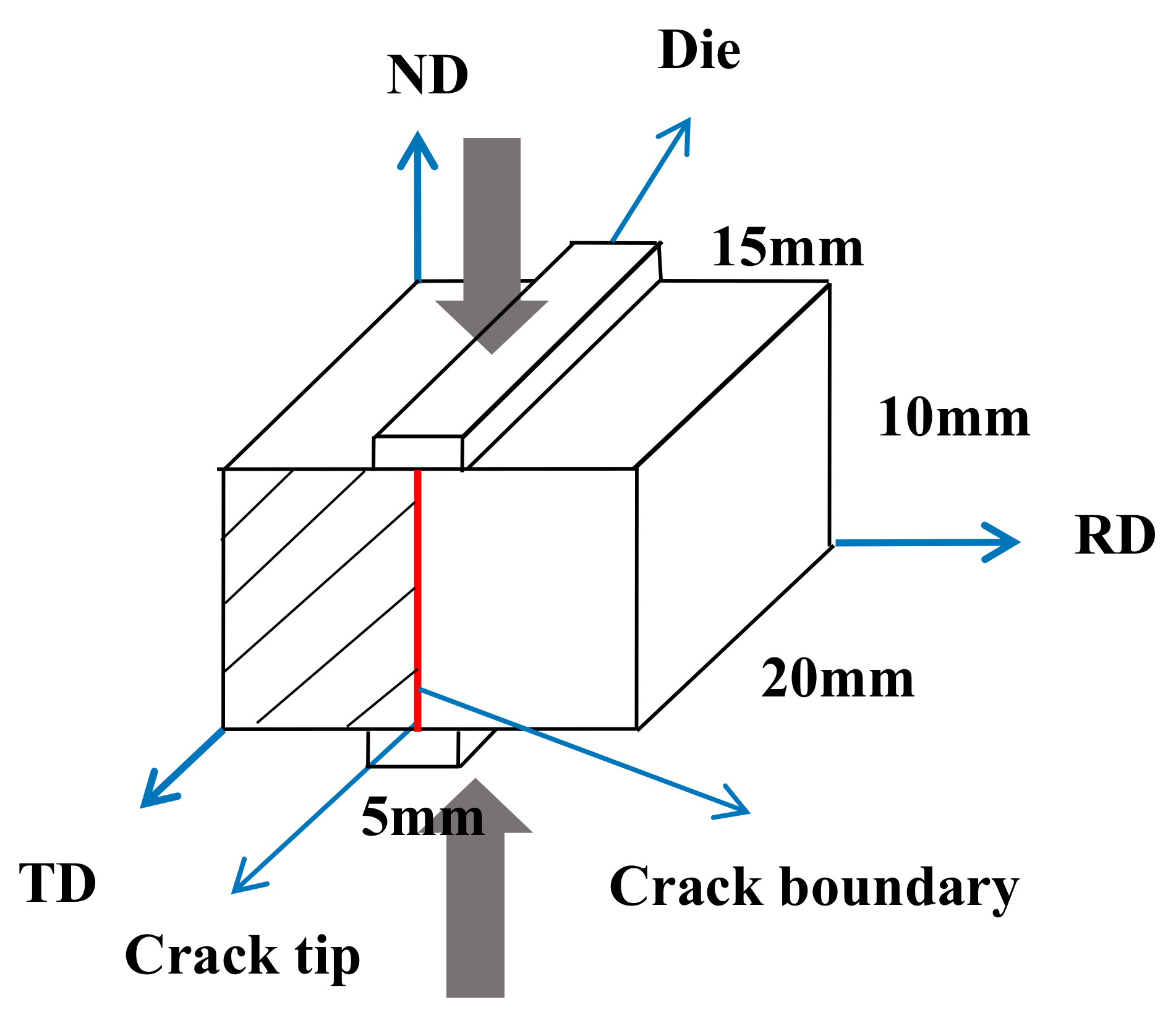
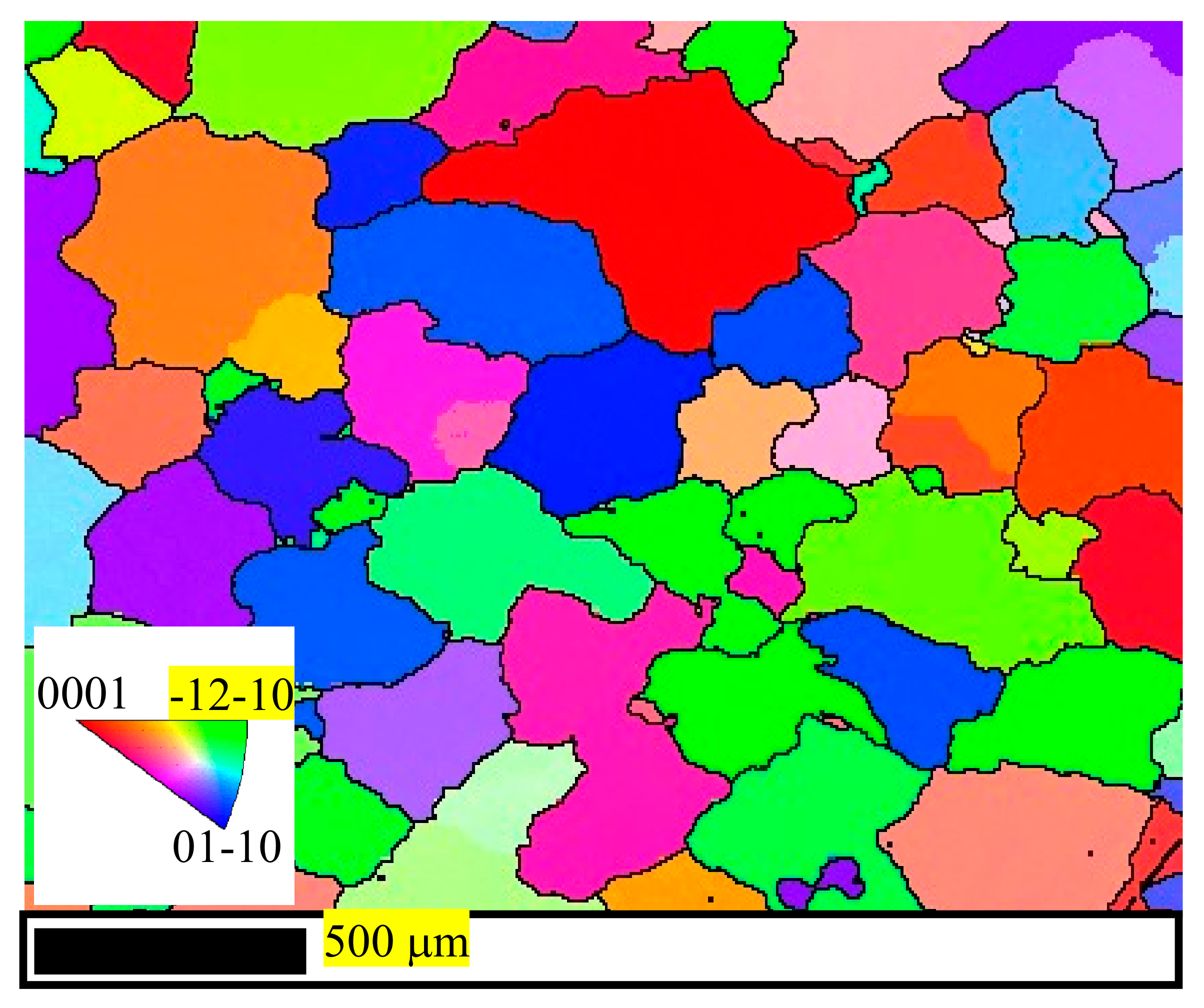
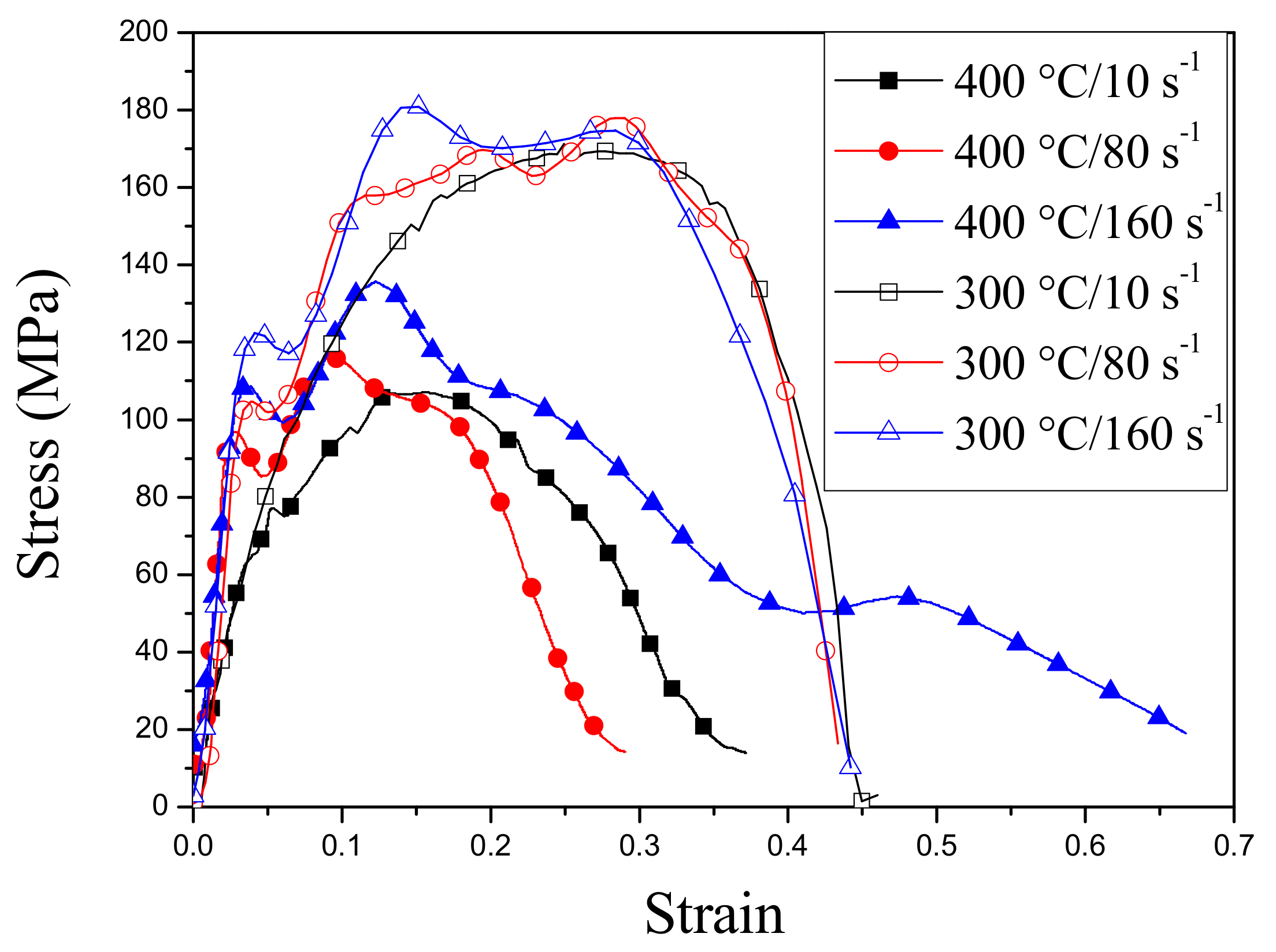

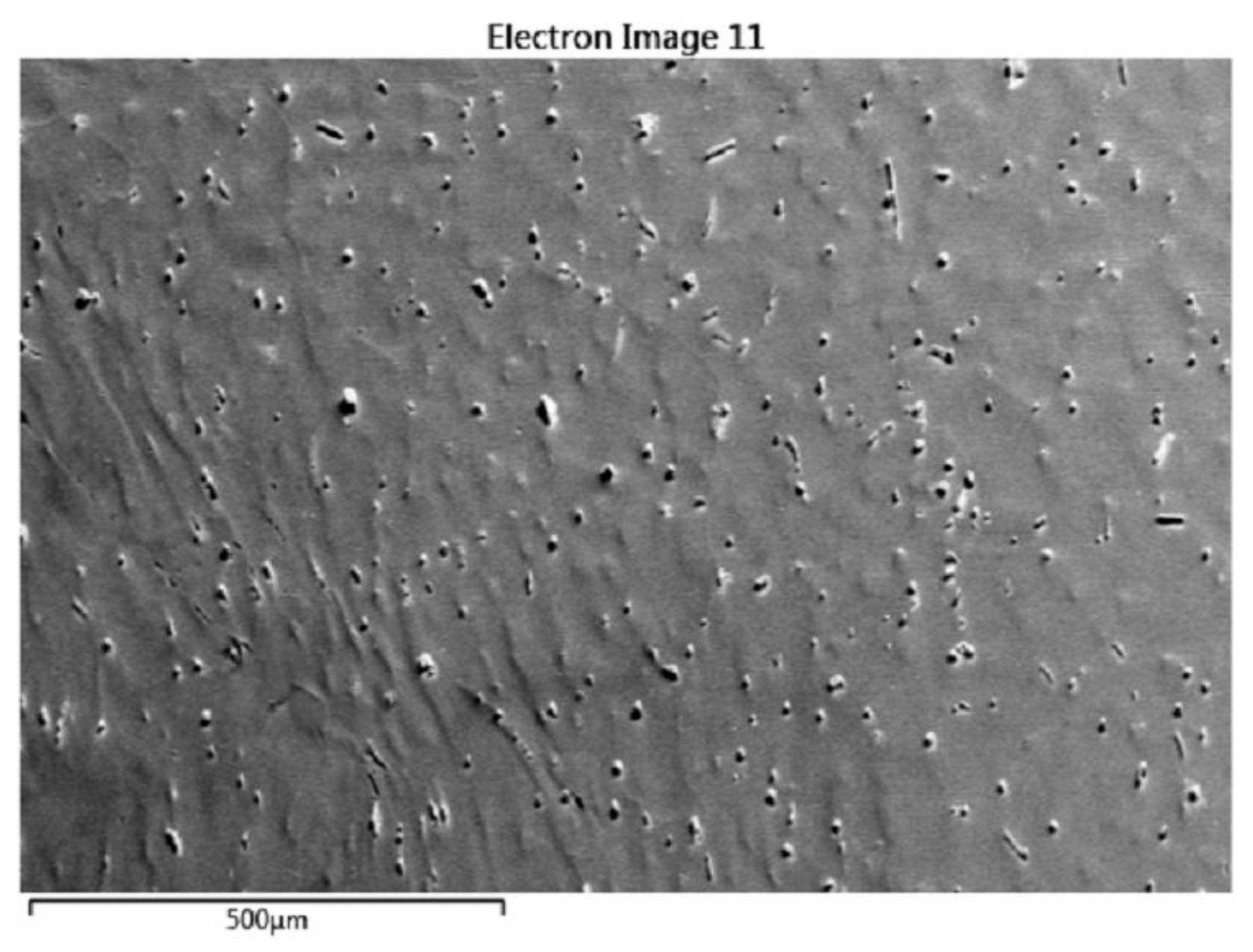
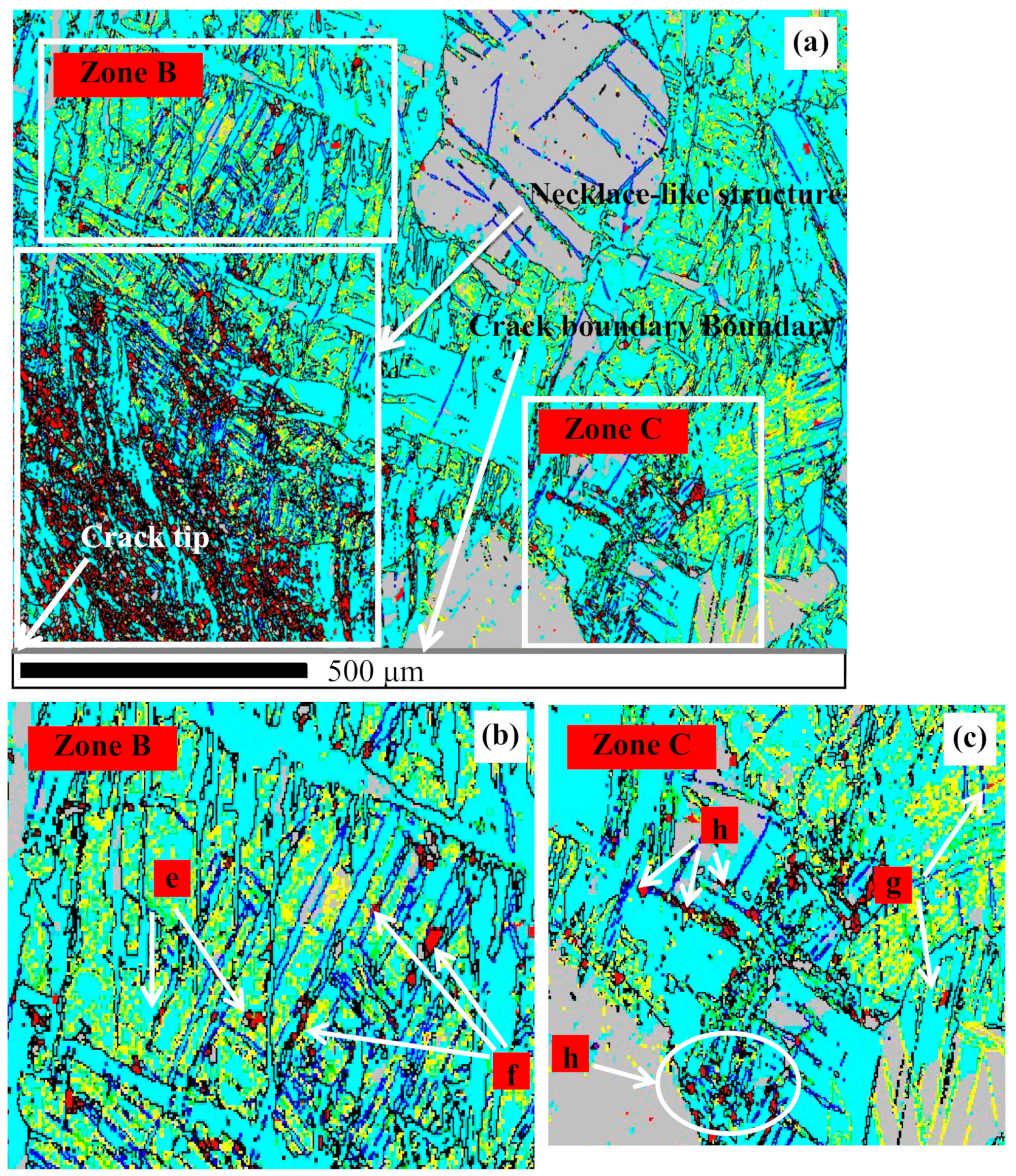
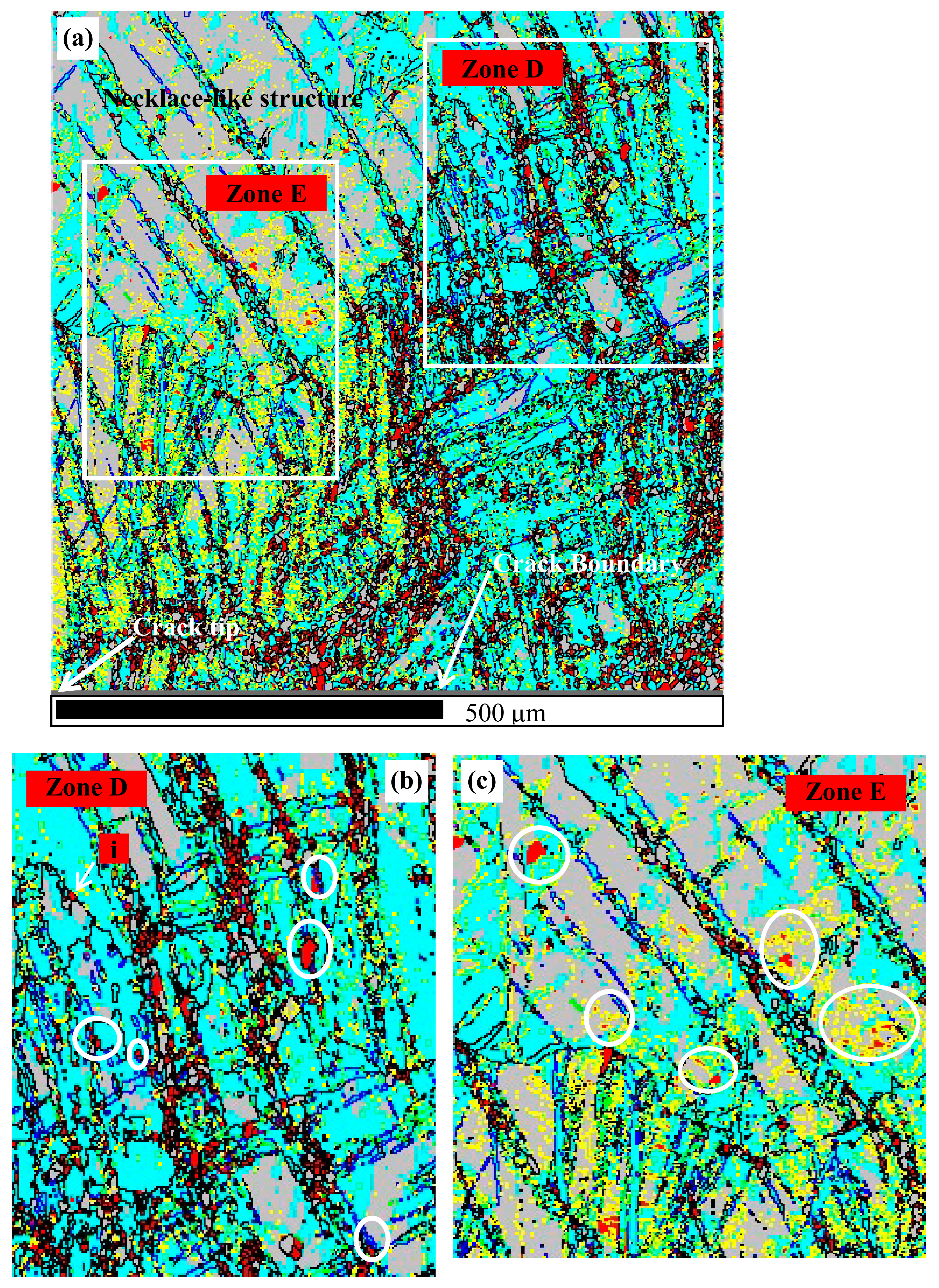
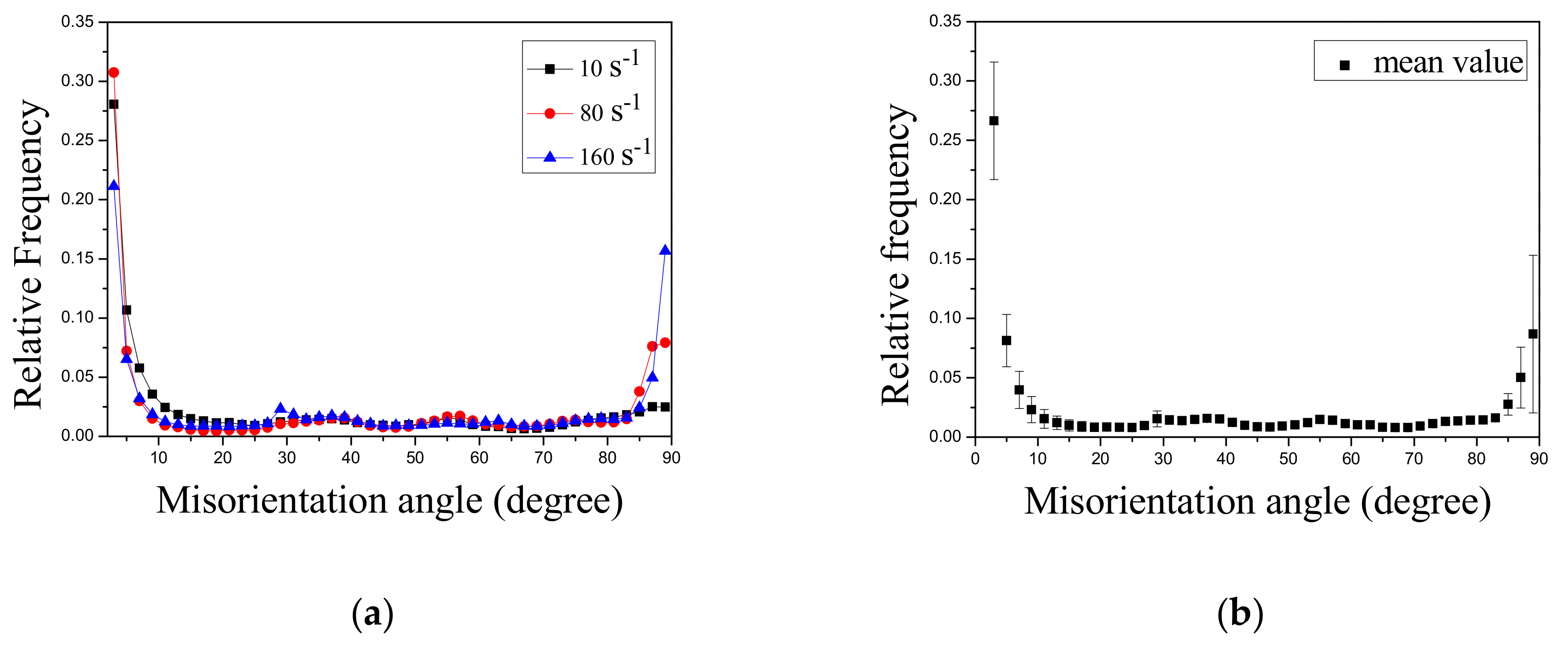
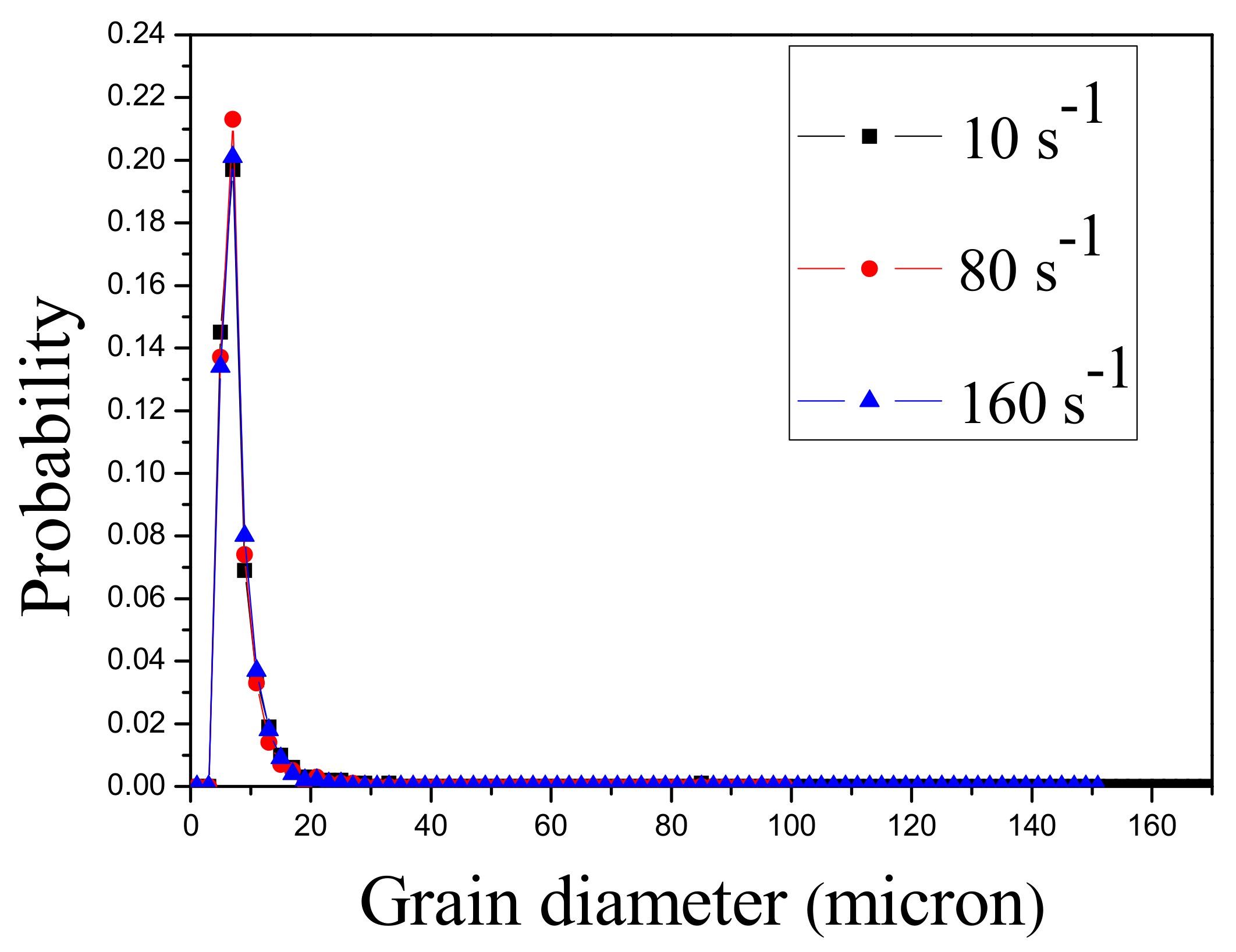
| Elements in AZ31 Mg Alloy | Weight Ratio (wt.%) |
|---|---|
| Mg | 95.30% |
| Al | 3% |
| Zn | 1% |
| Temperature (Unit: °C) | Strain Rate (Unit: s−1) | Twinning Volume Fraction (Unit: %) | ||
|---|---|---|---|---|
| CTW | DTW | ETW | ||
| 300 | 10 | 2.64 | 5.20 | 2.79 |
| 80 | 1.83 | 4.06 | 4.89 | |
| 160 | 1.04 | 2.27 | 9.12 | |
| Average | 1.84 | 3.84 | 5.59 | |
| 400 [14] | 10 | 0.08 | 0.92 | 17.80 |
| 80 | 2.33 | 3.57 | 7.78 | |
| 160 | 0.18 | 0.82 | 16.30 | |
| Average | 0.86 | 1.77 | 13.96 | |
| Temperature (unit: °C) | 300 | 400 [14] | ||||
| Strain rate (unit: s−1) | 10 | 80 | 160 | 10 | 80 | 160 |
| Average grain diameter (unit: μm) | 8.5402 | 8.0934 | 8.2257 | 34.958 | 33.280 | 28.486 |
| Standard deviation of grain diameters (unit: μm) | 7.3771 | 5.0217 | 5.3573 | 52.758 | 57.305 | 50.148 |
| Maximum of grain diameters (unit: μm) | 169.02 | 99.384 | 150.3 | 438 | 520.5 | 453 |
| Minimum of grain diameters (unit: μm) | 5.3524 | 5.3524 | 5.3524 | 1.5 | 1.5 | 1.5 |
| Ultimate strength (unit: MPa) | 171.16 | 177.88 | 180.78 | 105.76 | 115.50 | 135.30 |
© 2020 by the authors. Licensee MDPI, Basel, Switzerland. This article is an open access article distributed under the terms and conditions of the Creative Commons Attribution (CC BY) license (http://creativecommons.org/licenses/by/4.0/).
Share and Cite
Xu, L.; Xiang, M.; Wang, J.; Zhang, J.; Wang, C.; Xie, C. Analysis and Characterization on Dynamic Recrystallization in Casting AZ31 Mg Alloys Under Plane Strain Compression. Materials 2020, 13, 522. https://doi.org/10.3390/ma13030522
Xu L, Xiang M, Wang J, Zhang J, Wang C, Xie C. Analysis and Characterization on Dynamic Recrystallization in Casting AZ31 Mg Alloys Under Plane Strain Compression. Materials. 2020; 13(3):522. https://doi.org/10.3390/ma13030522
Chicago/Turabian StyleXu, Li, Minghua Xiang, Jun Wang, Jun Zhang, Chenning Wang, and Chao Xie. 2020. "Analysis and Characterization on Dynamic Recrystallization in Casting AZ31 Mg Alloys Under Plane Strain Compression" Materials 13, no. 3: 522. https://doi.org/10.3390/ma13030522
APA StyleXu, L., Xiang, M., Wang, J., Zhang, J., Wang, C., & Xie, C. (2020). Analysis and Characterization on Dynamic Recrystallization in Casting AZ31 Mg Alloys Under Plane Strain Compression. Materials, 13(3), 522. https://doi.org/10.3390/ma13030522





